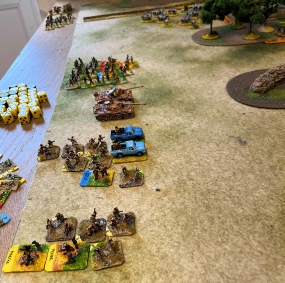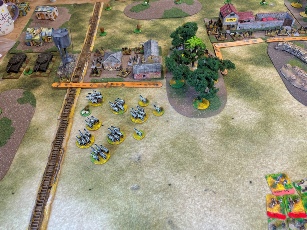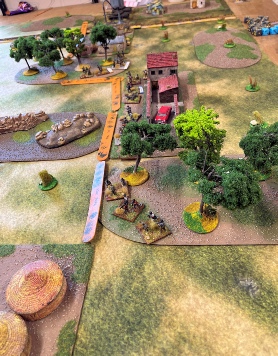AK47 Republic “People’s Edition”
(AKPE)
Free downloads
Battle sheet You need to use one of these each game.
Play sheet This has all you need for most of the game.

Publication date August 2025
Period of Warfare covered
War in Africa 1955 to 1990.
Peter Pig games always cover a narrow period in order to capture that period. Thus the most important aspects of that war can be modelled and
the less important ones piled into the general mechanisms.
Scale
Each square = 120 metres.
Each model figure represents 6 real soldiers. Each model vehicle represents 3 real vehicles.
Game setting
Army versus army defence/attack games.
Associated Peter Pig range
Range 17
Range 17- AK 47 republic. The PP WW2 range has suitable items too
Peter Pig always makes sure that the necessary stuff to play the game is available.
Game scenario generator
Players share 36 D6 into 5 scenario categories (no you don’t need 36 D6).
For each category players roll against each other and one player wins the category by 1,2,3 or 4.
This will generate 1,2,3,4 tokens
Leader (extra action points tokens) , Men (extra ability to assault tokens), Equipment (Better hits tokens), Cause (better morale tokens), Random (various, including minefield, sirocco, bush fire) .
Player with higher toekn total wil choose who attacks/defends.
Game table size
5 by 3 feet . Gridded into 6 inch squares.
Peter Pig games should fit on a normal living room table.
How much scenery needed
6 of 6x12" templates per player. Players do get choice over scenery piece types. In PP games both players take a full part. No alpha player choosing the armies, scenery, scenario and victory conditions.
Peter Pig games use templates to represent scenery areas. The trees and houses are indicative, not literal. Players could avoid using templates and just place appropriate scenery in squares.
How many D6 needed
15 D6 in total. Typically need 5D6 for shooting and 7 D6 for fights.
Piggy games allow a bunch of D6 to be rolled in order to bell curve the outcomes i.e. results group around the norm but extremes are possible.
Measurement method
Grid system. 6" squares. You could measure in multiples of 6" if grids are an anathema?
If measuring has to be very accurate, time is wasted and cheating/errors can occur.
Basing convention
Base size is not imperative, because it is a grid system.
Peter Pig rules use 3x3 cm bases for most troop types. This size is tactile. has the same frontage when turned and allows figure formations to have depth as well as width. 3x3 cm bases for 2,3 or 4 figures.
Typical army composition
Typical per army= 3 foot units each of 10 bases. Bases can include heavy weapons. 3 units of vehicles (tanks, AC, guns, Technicals) in pairs. General.
Most PP games use about 100 figures a side. enough for PP to make some big sales and not too many to paint.
Number of army composition lists included
A choice of 12 armies.
1. Religious Movement
2. People’s Popular Front
3. Colonial settlers
4. Western Supported
5. Communist supported
6. Superpower client
7. Dictatorship
8. Warlord Uprising
9. Hereditary benign dictatorship
10. Mercenary Cored
11. Exiled
12. End of days Government
Narrow period focus allows "in war" diversity to be modelled.

Here is an End of days army ready for the game. In the left distance are the units in reserve.
Unit motivation mechanism
3 motivations per unit commander.
He chooses 3 squares containing parts of his unit.
Rolls a D6 and that is the square’s action allowance.
With officer= owner re-rolls
In proximity= as it falls
More than proximity = roll, but opponent can demand a re-roll.
Action/moving mechanism
Bases in a square can move together or go in different direction/do different things. Action point cost depends on scenery type.
Something simple that can be memorised. PP rules give a move distance worth having.
Shooting mechanism
Shooting takes into account amount , skill and modifiers but ends up with a bunch of D6.
e.g. MG v foot =3D6, RCL v vehicle=2D6
Saving roll gets both players engaged. Shooting can result in pinning down the target. Return shooting and opportunity shooting too.
Close assault mechanism
Close assault is not hand to hand, as a square is 120m.
The assault mechanism only consider about 3 modifiers. But these are the important ones.
Another reason for keeping the period span small.
Then a handful of D6. 6 = kill. No saves. More decisive than shooting.
Morale mechanism
pair of D6. 9 or more=all Ok.
Less than 9 the unit risks losing bases.
Militia units degenerate quicker.
Game length
Most PP games last 5/6 turns. The games are always alternate move type, but with interaction via saves, reaction and opportunity. 2.5 Hours.
Countdown of 36. Players roll D6 with opportunity to re-roll. Deduct from countdown. This can be done by having 36 zebras on the table and deducting from the herd them each turn. Visually very nice.

Book keeping
Usually a few numbers to write down at the beginning but nothing after that.
Most games have a battle/planning sheet available as a free download on the PP website.
None after pre-game.
Principal victory condition
The two sides have different criteria to win.
Most victory conditions are awarded D6 multiples so their exact worth is not known until the game end.
Best parts
Bits we really like about the game.
1. Communication system. This creates reinforcements, air strikes etc.
2. Assaults. They can change the situation.
3. Scenery set up. Both players take part. No alpha gamer having it all set up before anyone arrives.
4. Choice of armies.

An example army. Religious movement
 AK Battle sheet
AK Play sheet
AK Battle sheet
AK Play sheet
 AK Battle sheet
AK Play sheet
AK Battle sheet
AK Play sheet